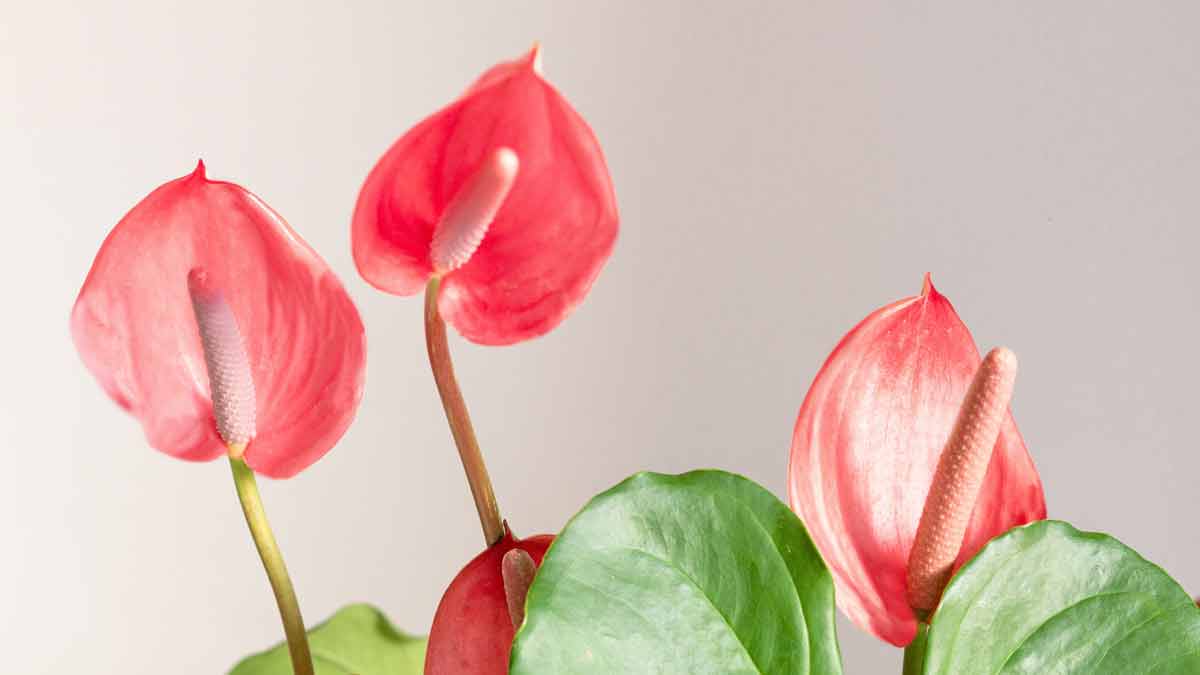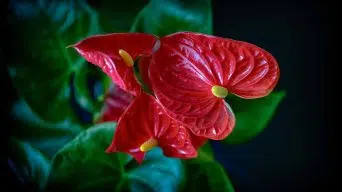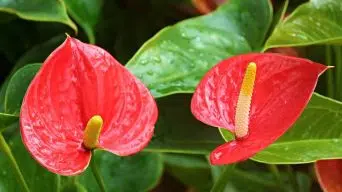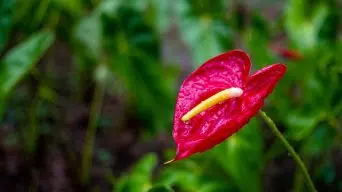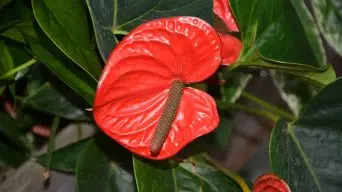To grow Anthuriums indoors, place them in bright, indirect light and keep the temperature between 60-85°F. Ensure the soil is moist but not waterlogged and repot as needed. Anthuriums prefer high humidity and can benefit from being grouped together. Avoid over-fertilizing and over-watering.
Welcoming a vibrant Anthurium plant into your home is an exciting adventure, but understanding how to care for it properly will ensure its beauty lasts.
This beginner-friendly guide covers essential care tips such as soil requirements, watering and humidity needs, light conditions, temperature preferences, and more – all designed to help you nurture the perfect environment for your flamingo flower.
Dive in with us as we explore the ins and outs of keeping your Anthurium thriving indoors!
Caring For Anthuriums Indoors
If you are planning to grow Anthuriums indoors, taking proper care of them is essential.
Choosing the right pot and soil, providing adequate light and humidity, and fertilizing and pruning regularly are essential steps to ensure optimal growth.
Following these simple tips, you can keep your Anthurium plant healthy and beautiful all year round.
Choosing The Right Pot
Selecting the ideal pot for your anthurium plant is crucial to ensure its health and longevity.
A well-draining container, such as a terracotta or ceramic pot with drainage holes, will prevent excess moisture from accumulating in the soil, reducing the risk of root rot.
To further aid in proper drainage and airflow around the roots, choose a pot slightly larger than the root ball but not oversized.
A moderately-sized pot allows room for growth while keeping your Anthurium cozy.
Soil Requirements
Anthurium plants thrive in a well-draining, peat moss or coco coir based soil mixture.
This soil type is essential to prevent root rot and provide the proper moisture for healthy growth.
When incorporating these materials into the potting mix, use a blend that retains some water but allows excess moisture to drain freely, ensuring your flamingo flower’s roots do not sit in soggy conditions.
If you’ve just brought home an Anthurium plant from the store, it’s crucial to inspect and possibly repot it if necessary.
Store-bought Anthuriums are often potted in rich, dense potting soil that doesn’t provide adequate drainage for this tropical indoor plant.
Remember that understanding how to care for Anthurium indoors starts with setting up a comfortable environment for its delicate roots!
Watering And Humidity Needs
Proper watering and humidity maintenance are crucial to ensure the healthy growth of your Anthurium plant.
These tropical plants prefer their soil to remain consistently moist but not soggy.
Overwatering may cause root rot, so letting the top inch or two of soil dry out between waterings is essential.
To achieve ideal moisture levels for your flamingo flower, you can adopt the “soak and drain” method in which you thoroughly water the plant until excess liquid drains out, then allow time for the soil to dry before repeating.
Achieving high humidity levels is equally important as anthuriums thrive in around 60-80% humidity environments.
Most indoor spaces have lower humidity, which can negatively impact your anthurium houseplant’s health.
One way to increase humidity for your potted plant is by placing it on a tray filled with pebbles and water; as the water evaporates, it increases surrounding moisture levels without soaking the roots directly.
Additionally, consider regularly misting your tropical plant using distilled or filtered water that will enhance foliage vigor while helping discourage pests like spider mites from inhabiting the leaves of your prized indoor plant.
Light Requirements And Placement
Anthuriums thrive in bright, indirect light. Direct sunlight can burn the leaves and lead to brown, burnt tips.
It’s best to place your anthuriums near a window with filtered light or use curtains to diffuse harsh rays that can damage the plant.
If you’re growing anthuriums in low-light areas, place them closer to a natural light source, like a window, for optimal growth and flowering.
The ideal spot for your Anthurium indoors receives bright but indirect sunlight throughout most of the day.
This could be on a windowsill with sheer curtains or further away from direct sun exposure in a room with large windows.
Remember that different Anthurium varieties will tolerate varying levels of light intensity, so it’s important to research specific requirements if unsure.
Remember, too much direct sunlight can harm these delicate plants; not enough may limit growth and flowering potential!
Temperature Requirements
Anthurium plants are sensitive to temperature changes and require a consistent, warm environment.
These tropical beauties prefer temperatures between 60° and 85°F (15.5° to 29°C) when grown indoors.
Avoid placing them near cold windows or drafty areas, as they can cause stress on the plant.
Flamingo Lilies, a type of Anthurium plant, thrive in temperatures hovering between 75 to 85 degrees during the daytime and 70 to 75 degrees Fahrenheit at nighttime.
If you live in cooler climates or your home’s temperature fluctuates throughout the day, consider using a space heater or moving your plant closer to a heat source like radiators.
Overall, providing consistent temperatures in the range of comfortable room temperature is ideal for Anthuriums as houseplants.
Monitor their response to environmental factors such as air conditioning and heating units, adjusting for optimal growth.
Fertilization
Fertilization is a crucial part of caring for your Anthurium plant indoors.
When it comes to fertilizing, the key thing to remember is balance.
Overfertilizing can lead to burned roots and damage to the plant.
Underfertilizing, on the other hand, can cause stunted growth and fewer flowers.
It’s best to use a balanced fertilizer with equal parts of nitrogen, phosphorus, and potassium during the growing season (spring through summer).
You should aim to fertilize once every two weeks at half-strength or as directed by the label instructions.
If you’re using slow-release granules, be sure not to over-apply them, as they can release too much nutrients at once.
Remember that different varieties of Anthuriums may require different fertilization ratios based on their individual needs.
Pruning And Maintenance Tips
Proper pruning and maintenance are essential for the healthy growth of Anthuriums, also known as Flamingo Flowers.
Here are some tips for maintaining your Anthurium plant:
- Remove Dead or Yellowing Leaves: To promote growth, remove yellow or dead leaves by cutting them off at the base of the stem.
- Cut Back Old Blooms: Once a flower has died, it’s best to cut it back to allow new blooms to take its place.
- Avoid Overwatering: Overwatering can lead to root rot in Anthurium plants. Ensure the soil is moist but not saturated, and do not allow standing water in the pot.
- Fertilize Regularly: Provide your Anthurium with a balanced fertilizer during its growing season (spring and summer). This will encourage healthy growth and vibrant blooms.
- Increase Humidity: Anthuriums thrive in high humidity environments. You can increase humidity by misting the leaves or placing a water tray near your plant.
Common Issues And Troubleshooting
If you’re an Anthurium plant owner, it’s important to be aware of the common issues to prevent damage to your plant.
Addressing the issue promptly can help ensure your Anthurium stays healthy and thriving.
Root Rot And Overwatering
Overwatering is the bane of Anthurium plants, and root rot is a common issue that can arise from it.
When the soil stays saturated for too long, it becomes a breeding ground for fungus, bacteria, and viruses that can damage or kill your plant’s roots.
Signs of root rot include wilted leaves, yellowing or browning foliage, slow growth, and overall discoloration.
To prevent this problem in your Anthurium plants, use well-draining potting soil with proper drainage holes at the bottom of your chosen container.
Water only when the top inch of soil feels dry to touch; avoid allowing water to pool on top of the soil or sit around the base of the plant.
If you suspect root rot has already taken hold in your plant’s roots, remove its affected parts immediately before repotting into a fresh potting mix.
Pest Infestations
Anthurium plants are susceptible to various pests, including aphids, fungus gnats, and mealybugs.
These insects can damage the plant’s leaves and flowers, causing them to wilt or die.
One way to control these pests is using insecticidal soap or neem oil spray.
Applying these solutions directly onto the affected areas can help eliminate the pests, but it’s essential to identify them correctly before using any treatment.
Another issue associated with Anthurium care is white fungus growth on the soil surface, which could be a sign of root rot caused by overwatering.
To prevent this problem from occurring, ensure you let the top layer of soil dry out before watering again.
Additionally, choosing well-draining potting soil and incorporating sphagnum moss or peat moss into it can aid in maintaining moisture without making the soil too soggy for your Anthurium plant’s roots.
Leaf Browning And Yellowing
One of the most common issues Anthurium plant owners face is leaf browning and yellowing.
This can be caused by several factors, including overwatering, underwatering, too much direct sunlight, or exposure to harsh chemicals.
To prevent this issue from occurring, it’s crucial to ensure that your plant is getting the right amount of water and light.
Ensure not to over-fertilize your Anthuriums, which can cause browning on leaves.
To fix yellow or brown leaves on your Anthurium plants, use sterilized tools to prune affected areas carefully.
Ensure you remove all dead or damaged parts while leaving healthy ones behind.
Adjust watering schedules gradually and move the plant away from direct sunlight if it gets too much of it.
Remember that some discoloration of older leaves is natural as new growth occurs at the base of each stem or flower spike for Anthurium flowers.
Wilting And Drooping
Anthuriums are known for their stunning blooms and glossy foliage, but if you notice your plant wilting or drooping, it’s essential to act fast to revive it.
There are several reasons why Anthurium plants may droop, including overwatering, underwatering, too much direct sunlight or not enough light, temperature extremes, and pest infestations.
To determine the cause of your plant’s distress, closely examine its leaves and soil moisture levels.
Adjust the watering schedule accordingly and consider moving your Anthurium to a location with brighter but indirect light.
One common cause of wilting in Anthuriums is root rot due to overwatering or soggy soil.
If this is the case for your plant, remove it from its pot immediately and wash off any roots that appear brown or mushy.
Repot into fresh potting soil with good drainage to promote healthy new growth.
Another potential culprit could be pests like spider mites or aphids, which can weaken an Anthurium plant causing drooping leaves.
Use insecticidal soap as the manufacturer directs to eliminate pests sucking the life out of your prized houseplant.
Final Thoughts
Caring for Anthuriums indoors can be a rewarding and enjoyable experience for plant enthusiasts of all levels.
By following these tips, you can ensure that your Anthurium will thrive in any indoor environment.
With its vibrant heart-shaped spathes and year-round blooming capabilities, this tropical plant will surely add color to any space it inhabits.
Remember to watch for common issues such as root rot or pest infestations but don’t hesitate to troubleshoot if necessary.
Your efforts will pay off with beautiful, long-lasting blooms that will brighten your home!

